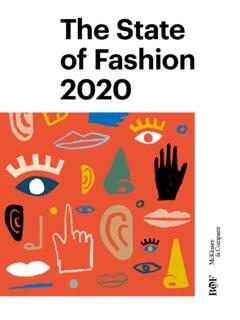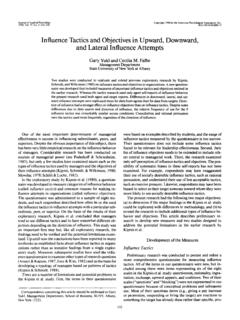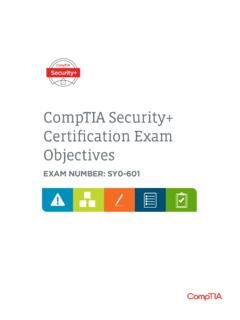Transcription of Feser / When Execution Isn’t Enough - McKinsey & Company
1 Feser / When Execution Isn't Enough / 2. Chapter 3: The Science of influence Inspirational appeals are the most effective influence tactics in getting people to commit to action.. Leadership is influence . John C. Maxwell influence has long been recognized as an essential element of leadership. A. commonly used definition of leadership states that leadership is a process of social influence in which one person is able to enlist the aid and support of others in the accomplishment of a common task. 1 influence is a primary social mechanism through which a leader enacts his or her Ample literature and research addresses the science of influence . Notably, leaders turn to the theory of influence , based on the principles of reciprocity, commitment, and consistency, social proof, authority, liking, and scarcity, developed by Robert Cialdini,3 a psychologist at Arizona State University, or to the study of influence tactics by Gary Yukl, a psychologist at the State University of New York at Albany.
2 In the early 1980s, Kipnis, Schmidt, and Wilkinson initiated one of the main streams of research on influencing They spearheaded an empirical approach for studying the process of influence by collecting critical incident reports in which people in a work setting described how they got their way with someone else in their organization. Leveraging these reports, they developed an instrument called the Profile of Organizational influence Strategies (POIS)5 to measure the frequency with which various people within organizations use specific influencing tactics . This original instrument has been used and refined over the last 30 years to provide a solid foundation for our understanding of the influencing behaviors that people actually use in the This stream of research has led to the identification of nine influence approaches, that is, inspirational appeals and eight others. Three of them are known as hard tactics , and six of them as soft tactics . They are shown in Figure Feser / When Execution Isn't Enough / 3.
3 Figure The Nine influence tactics The hard tactics on the left are simple and straightforward. Leaders carry them out simply by building on their own perspectives. The soft tactics on the right are more complex and require the ability to influence based on the followers' perspectives, characteristics, and inner motivators. We review them in turn. The Hard tactics The hard influence approaches are requesting, legitimating, and building coalitions. REQUESTING. Requesting is probably the simplest influence approach. Requesting is when the leader uses simple demands to get others to take action. Requesting means gaining the commitment of the people you lead by making a direct statement of what you want and by asserting your position confidently and certainly. Requesting also includes the use of frequent checking and persistent reminders to get people to act. Requesting is the influence approach at the core of command and control leadership. Feser / When Execution Isn't Enough / 4.
4 Requesting is in use when a Company leader gives orders to a team of direct reports during a turnaround program, when a team leader asks a team member to get something done, or when a sergeant orders a squad of soldiers to attack an enemy's position. Requesting often referred to as pressure tactics in academic papers is based on the principle of authority, meaning that people tend to obey authority figures, even if these authorities ask them to perform objectionable The famous Milgram experiments conducted by Yale University psychologist Stanley Milgram in the 1960s explored the principle of authority. These tests demonstrated that people are willing to obey authority figures who instruct them to perform activities that conflict with their personal Requesting or command and control tactics may have negative connotations; in fact, people often equate them with being threatened. However, requesting per se is not a negative approach. It is just the simplest way to make a demand in a nonthreatening way, leaving no room for negotiation, but also not suggesting punishment or other consequences.
5 Typical statements by a leader using requesting are: I want you to inform Jack that.. Could you please call Frank and .. ? . I did ask you to inform him. Have you had a chance to do it? . LEGITIMATING. Legitimating is slightly more complex than requesting in that a leader adds a legitimation or rationalization for the command and control approach. With legitimating the leader seeks to establish the legitimacy of a request or to state that he or she has the authority to make it. Legitimating means using authority or credentials to explain and influence , for instance, when leaders show that what they want is consistent with policy, procedure, or Company culture. Leaders who refer to management directives, laws, rules, supportive corporate authorities, or recognized experts are legitimating. Typical statements by a leader using legitimating tactics include: According to policy, all air travel must be.. The CEO has asked me to look into.. As you know, it is a standard practice that.
6 Feser / When Execution Isn't Enough / 5. COALITION. Coalition is similar to legitimating; however, its standing doesn't come from references to any form of authority. Leaders using this approach enlist other people's help and use their support as a way to get the people they lead to do The use of coalition tactics often indicates that leaders are getting others to help them extend influence or reach goals they could not accomplish on their own. Coalition tactics include creating a network of supporters to extend the leader's power base, building consensus, defining a group position, or creating an us-versus-them . situation. Leaders who cite the names of their supporters when they make a request are also using this tactic. Typical statements by a leader using coalition tactics are: Jack and I both think that.. Everyone on the finance team says.. As a team, we have decided that.. Everybody thinks it is a good idea to.. The Soft tactics There are six soft approaches to influencing others: rational persuasion, socializing, exchanging, personal appeals, consultation, and inspirational appeals.
7 On a rising scale, they increasingly focus on the people being influenced as the source of energy for carrying out the actions requested. RATIONAL PERSUASION. Rational persuasion is a simple tactic. It combines the request of the pressure approach with logical arguments supporting the request. With the rational persuasion tactic, leaders use logical arguments and factual evidence to show that a request is feasible and relevant to reaching important Rational persuasion uses logic, rationale, or evidence to explain or justify a position, and to show that the leader's perspective is the most logical alternative. Feser / When Execution Isn't Enough / 6. To make a case using rational persuasion, leaders rely on having the knowledge or expertise to present facts analytically or they provide charts, graphs, data, statistics, photographs, or other forms of proof. Typical statements by a leader using rational persuasion tactics are: The Company 's transformation is necessary to achieve growth, to reduce costs, and to beat the competition.
8 Given the data available, the most logical approach is.. I want you to take action. The facts suggest three reasons for moving ahead.. The logic in rational persuasion is the leader's logic. While the leader adds supporting arguments, rational persuasion is still an approach to influence that like hard tactics is articulated top down from the leader's perspective, and not from the ground up. SOCIALIZING. With socializing, leaders start to take an interest in those they are trying to lead. Socializing uses praise and flattery before or during an attempt to get others to carry out a request or support a Socializing means establishing a basis for asking, behaving in a warm and cordial manner to influence others to act, being friendly, disclosing personal information, or building a relationship. It includes building rapport by identifying commonalities, and matching behaviors or conversational pacing. Socializing is based on the principle of liking, which says people are more easily persuaded by those they Typical statements by a leader using socializing tactics are: I am very impressed by what you have achieved.
9 That really shows lots of commitment and dedication. It would be great if you could.. I see the problem exactly the same way.. I also have two kids.. Academic papers sometimes refer to socializing as ingratiation.. PERSONAL APPEALS. Personal appeals are more focused on other people, as they assume some form of relationship and trust between a leader and those being influenced. With personal appeals the leader asks others to carry out a request or support a proposal out of friendship, or asks for a personal favor before saying what it Making a personal appeal means asking based on friendship, loyalty, trust, or a past relationship. Leaders using personal appeals might tell staffers they are counting on their support. Feser / When Execution Isn't Enough / 7. Typical statements by a leader using personal appeals are: You and I go back a long time in this Company . I'd really like your help on.. I need to ask you for a favor.. Can I count on you guys making .. ? . EXCHANGING.
10 Exchanging is even more focused on others because it assumes that the leader understands what is valuable and important to the people being influenced. With exchanging, leaders give something of value to the people being led in return for getting something they want. Exchanging is based on the concept of reciprocity, which says people tend to return a The leader offers others something they may want or offers to reciprocate at a later time if the others will do as Negotiating, bargaining, or trading something, offering something with explicit or implicit expectations of receiving something in return, reciprocating, swapping favors or benefits, creating a win-win or a give-and-take situation, compromising, or making a concession in return for a concession are forms of exchange. Typical statements by a leader using exchanging tactics are: In return for participating in this employee survey, I will send you the aggregated results.. If you support the decision, I will support your request.

















